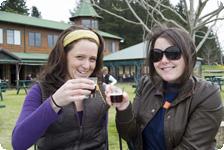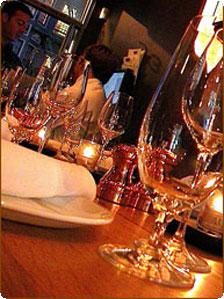by Amy Lynch
After flying eight hours to visit my boyfriend in Germany for a month, I soon realized that I was not content simply to sit in his apartment and watch music videos during his workweek.
Hence, I cooked up plans to take some side trips on my own to the cities I’ve always wanted to see, a thought that alternately made me feel completely empowered and scared shitless. My first big solo venture in Europe—a four-and-a-half-hour train ride from Mainz to Cologne and then on to Amsterdam.
As the train crossed the German border into the Netherlands, the Rhine River landscape gave way to sheep grazing in green fields, and to my delight, actual working windmills. Alas, as it was January: there were no tulips in bloom.
Amsterdam itself is an unbelievable assault on the senses, with too many sights, sounds, tastes, and smells to keep track of at one time. It’s an overwhelming, swirling, teeming carnival of people and activity.
The city is built on a series of canals, which make a visually stunning backdrop for rows of charming townhouses interlaced with secretive little walkways. The cobbled streets are narrow and bicycles seem to be the preferred mode of transportation. Public transportation is big here, too. Trams, cabs and buses carry fares to and fro, and quaint water taxis cruise the canals.
The pedestrian thoroughfares are jammed with shops, restaurants, and the ubiquitous cafés. Every few steps, your nose encounters a new smell: sweet donuts, tempting french fries, and, of course, wafts of hash. I think I inadvertently got stoned just walking to my hotel. The “brown cafés” that offer hash feature hookah pipes in the window, but really, there’s not much question which ones allow smoking based on smell alone. “Smart shops” vend psychedelic mushrooms and other such goodies, although being the puritanical just-say-no American that I am, none of it seemed very smart to me and I stayed away.
It’s easy to get your bearings here. The streets are laid out on a grid system, with the main thoroughfares spanning out from the train station like spokes in a wheel. The Neiuwdijk, a lively pedestrian street, offers trendy clothing stores and souvenir shops. The Leidesplein area is another main shopping and entertainment district complete with tourist traps like a Hard Rock Café. Most of the locals speak English as well as Dutch, and are friendly and accommodating.
Whenever you tell someone you’ve been to Amsterdam, their first question is always, “Did you go to the red light district?” The sex industry in Amsterdam is impossible to ignore. My in-room TV selections in the hotel included free porn movie previews, and I’m not sure, but I think I might have been propositioned by a little old Dutch man as I stood on the canal eating a waffle. Sometimes not knowing the language can be a blessing in disguise.
No matter what you may have heard about the red light district, nothing prepares you for seeing it up close and personal for the first time. Sex is so in-your-face here, it’s desensitizing. The district is not really very big, but there are sex shops, adult movies, and live sex shows on every corner. I was walking down the street and almost jumped out of my skin when I realized the lingerie-clad women in the windows were real people and not mannequins. How strange that you can window-shop for sex here as you would a new purse or pair of shoes. It’s shocking at first, but after walking by the tenth or twentieth window, it’s no big deal. In the heart of the district, there is a prostitution information center, which I didn’t visit, but I assume distributes condoms and extols the benefits of safe sex.
For all of its notoriety, I felt very secure walking around the red light district by myself during the daytime, although I was a little too chicken to go back there by myself after dark. The streets were far from empty and were populated with men and women of all ages. I even spied a few kids and families on the premises. (A helpful tip: don’t take photos of the ladies in the windows unless you want your camera confiscated by scary ape-like proprietors who will chase you down the street to get your film.)
After the novelty of the red light district wears off, you realize that Amsterdam has much more to offer besides sex and smoking. The Anne Frank House is a must-see. The little row house is so unassuming, you’d never know what it was if it weren’t for the queue stretching out the door and around the corner. I waited forty-five minutes to get inside, and it was worth every single second.
For those who live under a rock and have never read The Diary of Anne Frank, Anne and seven other Jews hid from the Nazis for two years in a small set of rooms above her father’s store. They were eventually betrayed, discovered, and sent to concentration camps where everyone but Anne’s father perished.
The museum is set up as a walking tour, with information stations throughout: video-projected explanations and displays detail the history of each room and the experiences of Anne Frank and her family. It is deeply moving to walk through this tiny series of rooms and realize that eight people were able to survive here for two years behind papered windows without sunlight or fresh air. That a small girl of twelve couldn’t run or play or go outside for two such formidable years of her life seems unimaginable.
I found myself fighting back tears several times throughout the tour. It’s hard to believe the simple diary of a young girl could have such a profound effect for so long and for so many. Anne Frank had hoped to be a famous writer, and she got her wish. Unfortunately, she never lived to see the impact of her words.
The museum also features a thought-provoking interactive display that allows participants to view a series of controversial video scenarios and vote as to whether they believe each circumstance to be freedom of speech or persecution. There’s also a café and a gift shop that carries The Diary of Anne Frank in every translation imaginable.
The Museumplein is a fabulous place to while away the day by taking in some of the best art in the world. Several museums surround a vast open green space complete with an ice skating rink. This would be an ideal spot for a summer picnic lunch. The huge Rijksmuseum was under construction during my visit, but I visited the Van Gogh Museum and found its mix of classics by the master and newer, modern exhibits worthwhile.
The cuisine of Amsterdam is an international melting pot. Any kind of food you can imagine from any country is available here. Local specialties include broodjes, (tasty open-faced sandwiches filled with meats and cheeses); falafel; dense waffles topped with a variety of yummy things like chocolate, nuts, and powdered sugar; and french fries with a mayonnaise sauce for dipping.
Baristas ask if you like your coffee black or white (with milk). Either way, it’s charmingly presented on a tray or small platter, usually along with some kind of small cookie or wafer.
I had a dinner in a small Turkish restaurant on the corner of my hotel and amused myself by writing in my journal and eavesdropping on the conversation of three hunky Australian guys at the table next to me. My falafel was not as tasty as I’d hoped, but the fries were excellent.
For another meal, I met a friend Brian and his Dutch husband Hidde at Yagamama, a Japanese chain restaurant. The food was lovely, with elements of Asian and Thai. I had a delicious noodle bowl with chicken, curry, cilantro, and bean sprouts. It was very enlightening to talk to a gay couple about living in such a laissez-faire society. Liberal is not the word for Amsterdam; you get the feeling that walking naked down the street is possible and accepted here.
As my time in Amsterdam wound down and my train back to Germany pulled out of the station, the sun was just setting and I was treated to a picture-perfect last glimpse of the town just starting to light up under the darkening sky. It was a perfect farewell kiss to a city like no other.
* * * *
Amy Lynch is a freelance writer. She lives in Sonoma, California with her husband.




